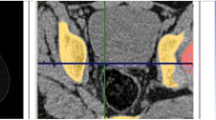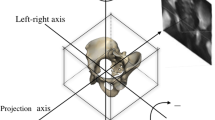Abstract
Purpose
To compare acetabular version angle measurements of CT scans in the prone and reformatted supine positions. CT acetabular version angle measurements have previously been done in the prone position to correct for pelvic tilt. With the advent of multidetector CT, recent studies have evaluated acetabular version angles measured in the supine position. To our knowledge, a comparison between these two approaches has not been performed.
Study design
Case series in which consecutive CT urography studies of 49 adult patients performed in both prone and supine positions were retrospectively reviewed, and acetabular version angles of both hips measured.
Method
Retrospective review of 49 consecutive CT urography studies performed in both prone and supine positions was done, and acetabular version angles of both hips were measured. Two radiologists measured the acetabular version angles independently. Multiplanar reformation of the supine CT images was performed to compensate for pelvic tilt and rotation prior to angle measurements.
Results
There was excellent interobserver agreement between the two readers (ICC = 0.90). Acetabular version angle measurements from the prone CT images were larger compared to reformatted supine images (24.0 and 21.3°, respectively, p < 0.0001), with greater angles found in women. There was strong correlation between supine and prone acetabular version angle measurements with a Pearson correlation coefficient of 0.743.
Conclusions
Acetabular version angles measured from prone and reformatted supine CT images show strong correlation but are significantly different with larger angles obtained from the former and in women; clinical implications of these findings may require further study in other to determine the best method of version angle measurement. CT acetabular version angle measurement is also reliable with excellent interobserver correlation.





Similar content being viewed by others
References
Kang AC, Gooding AJ, Coates MH, Goh TD, Armour P, Rietveld J. Computed tomography assessment of hip joints in asymptomatic individuals in relation to femoroacetabular impingement. Am J Sports Med. 2010;38(6):1160–5.
Tönnis D, Heinecke A. Acetabular and femoral anteversion: relationship with osteoarthritis of the hip. J Bone Joint Surg Am. 1999;81(12):1747–70.
Ezoe M, Naito M, Inoue T. The prevalence of acetabular retroversion among various disorders of the hip. J Bone Joint Surg Am. 2006;88(2):372–9.
Siebenrock KA, Schoeniger R, Ganz R. Anterior femoro-acetabular impingement due to acetabular retroversion. Treatment with periacetabular osteotomy. J Bone Joint Surg Am. 2003;85-A(2):278–86.
Tannast M, Siebenrock KA, Anderson SE. Femoroacetabular impingement: radiographic diagnosis—what the radiologist should know. AJR Am J Roentgenol. 2007;188(6):1540–52.
Reynolds D, Lucas J, Klaue K. Retroversion of the acetabulum. A cause of hip pain. J Bone Joint Surg Br. 1999;81(2):281–8.
Siebenrock KA, Kalbermatten DF, Ganz R. Effect of pelvic tilt on acetabular retroversion: a study of pelves from cadavers. Clin Orthop Relat Res. 2003;407:241–8.
Stem ES, O’Connor MI, Kransdorf MJ, Crook J. Computed tomography analysis of acetabular anteversion and abduction. Skeletal Radiol. 2006;35(6):385–9.
Dandachli W, Ul Islam S, Tippett R, Hall-Craggs MA, Witt JD. Analysis of acetabular version in the native hip: comparison between 2D axial CT and 3D CT measurements. Skeletal Radiol. 2011;40(7):877–83.
Maruyama M, Feinberg JR, Capello WN, D’Antonio JA. The Frank Stinchfield Award: morphologic features of the acetabulum and femur: anteversion angle and implant positioning. Clin Orthop Relat Res. 2001;393:52–65.
Kim SS, Frick SL, Wenger DR. Anteversion of the acetabulum in developmental dysplasia of the hip: analysis with computed tomography. J Pediatr Orthop. 1999;19(4):438–42.
Anda S, Terjesen T, Kvistad KA. Computed tomography measurements of the acetabulum in adult dysplastic hips: which level is appropriate? Skeletal Radiol. 1991;20(4):267–71.
Visser JD, Jonkers A, Hillen B. Hip joint measurements with computerized tomography. J Pediatr Orthop. 1982;2(2):143–6.
Abel MF, Sutherland DH, Wenger DR, Mubarak SJ. Evaluation of CT scans and 3-D reformatted images for quantitative assessment of the hip. J Pediatr Orthop. 1994;14(1):48–53.
Anda S, Svenningsen S, Grontvedt T, Benum P. Pelvic inclination and spatial orientation of the acetabulum. A radiographic, computed tomographic and clinical investigation. Acta Radiol. 1990;31(4):389–94.
Dandachli W, Kannan V, Richards R, Shah Z, Hall-Craggs M, Witt J. Analysis of cover of the femoral head in normal and dysplastic hips: new CT-based technique. J Bone Joint Surg Br. 2008;90(11):1428–34.
Dandachli W, Islam SU, Liu M, Richards R, Hall-Craggs M, Witt J. Three-dimensional CT analysis to determine acetabular retroversion and the implications for the management of femoro-acetabular impingement. J Bone Joint Surg Br. 2009;91(8):1031–6.
Park MS, Chung CY, Lee SH, Cho TJ, Yoo WJ, Choi IH. Two-dimensional computed tomographic measurement of acetabulum—reliability, validity, and limitation. J Pediatr Orthop. 2008;28(8):812–8.
Acknowledgments
The authors would like to thank Dr. Tina Xu for assistance rendered in statistical analysis of the study data.
Disclosure
The authors declare that they have no conflicts of interest.
Author information
Authors and Affiliations
Corresponding author
Rights and permissions
About this article
Cite this article
Chong, L.R., Too, C.W. Comparison of acetabular version angle measurements between prone and reformatted supine computed tomography images. Skeletal Radiol 43, 289–295 (2014). https://doi.org/10.1007/s00256-013-1781-6
Received:
Revised:
Accepted:
Published:
Issue Date:
DOI: https://doi.org/10.1007/s00256-013-1781-6




